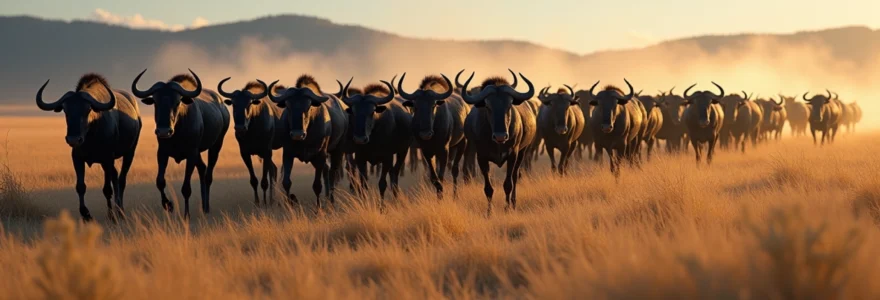Embarking on a wildlife travel adventure offers a unique opportunity to witness the raw beauty of nature and forge unforgettable connections with animals in their natural habitats. From the vast savannas of Africa to the icy expanses of the Arctic, our planet boasts an incredible diversity of ecosystems teeming with fascinating creatures. As travellers seek more meaningful and sustainable experiences, wildlife encounters have become increasingly popular, offering not just thrills but also valuable insights into conservation efforts and the delicate balance of our natural world.
Ecological tourism: principles and best practices for wildlife encounters
Ecological tourism, or ecotourism, is a form of responsible travel that prioritises conservation, community welfare, and sustainable practices. When it comes to wildlife encounters, adhering to ecotourism principles is crucial for protecting both the animals and their habitats. Responsible wildlife tourism can contribute significantly to conservation efforts, providing financial support and raising awareness about endangered species and ecosystems.
One of the fundamental principles of ecological tourism is minimising impact. This means respecting wildlife by maintaining a safe distance, avoiding loud noises or sudden movements, and never feeding wild animals. It’s essential to choose tour operators that prioritise animal welfare and follow strict ethical guidelines. These operators often employ local guides with extensive knowledge of the area’s flora and fauna, enhancing the educational value of the experience.
Another critical aspect of responsible wildlife tourism is supporting local communities. By choosing locally-owned accommodations and services, travellers can ensure that the economic benefits of tourism remain within the community. This, in turn, incentivises local populations to protect wildlife and their habitats, as they become valuable resources for sustainable livelihoods.
Responsible wildlife tourism is not just about observing animals; it’s about understanding their ecosystems, the challenges they face, and how we can contribute to their conservation.
When planning a wildlife travel experience, consider the following best practices:
- Research and choose ethical tour operators with strong conservation credentials
- Respect wildlife by maintaining appropriate distances and following guide instructions
- Support local communities by using local services and purchasing sustainably-made souvenirs
- Minimise your environmental impact by following Leave No Trace principles
- Educate yourself about the species and ecosystems you’ll be visiting
Africa’s serengeti: witnessing the great wildebeest migration
The Great Wildebeest Migration in Africa’s Serengeti ecosystem is often described as one of the most spectacular natural events on Earth. This annual movement of over 1.5 million wildebeest, accompanied by hundreds of thousands of zebras and gazelles, is a breathtaking display of nature’s grandeur and the struggle for survival.
The migration is not a single event but a continuous circular movement spanning the Serengeti National Park in Tanzania and the Masai Mara National Reserve in Kenya. This epic journey covers approximately 1,800 miles and is driven by the animals’ search for fresh grazing and water sources. The cycle of life and death plays out dramatically during this migration, with predators such as lions, cheetahs, and crocodiles taking advantage of the abundance of prey.
Optimal viewing locations in serengeti national park and masai mara
To witness the Great Migration, travellers can choose between various locations in the Serengeti and Masai Mara, each offering unique perspectives on this natural spectacle. In the Serengeti, the central Seronera area is an excellent year-round location, while the Western Corridor is ideal for watching dramatic river crossings. The Northern Serengeti, including the Kogatende area, offers spectacular views of the herds crossing the Mara River.
In the Masai Mara, the Mara Triangle is renowned for its excellent game viewing opportunities, particularly during the migration season. The area around the Mara and Talek rivers is also popular for witnessing river crossings, which are often considered the most dramatic events of the migration.
Timing your visit: understanding migration patterns and seasons
The timing of the Great Migration is dictated by rainfall patterns and the availability of fresh grazing. While the exact timing can vary from year to year, there is a general pattern that travellers can use to plan their visits:
- December to March: The herds are in the southern Serengeti, where calving season occurs
- April to June: The migration moves northward through the central and western Serengeti
- July to October: The herds cross into the Masai Mara, with spectacular river crossings
- November: The migration begins its southward journey back to the Serengeti
It’s important to note that while these patterns are generally consistent, climate change and varying rainfall patterns can affect the timing and routes of the migration. Consulting with experienced tour operators can help ensure you plan your visit during the optimal time for wildlife viewing.
Ethical safari operators: choosing responsible tour companies
Selecting an ethical safari operator is crucial for ensuring a responsible and sustainable wildlife experience. Look for companies that are members of recognised ecotourism associations and have clear conservation policies. Ethical operators should prioritise animal welfare, employ knowledgeable local guides, and contribute to community development and conservation initiatives.
Some key factors to consider when choosing a safari operator include:
- Commitment to sustainable practices and conservation efforts
- Use of eco-friendly accommodations and vehicles
- Employment of local staff and support for community projects
- Clear guidelines on wildlife viewing practices and guest behaviour
- Positive reviews from previous travellers, particularly regarding their ethical practices
Photography techniques for capturing wildebeest river crossings
Photographing the wildebeest river crossings during the Great Migration can be challenging but incredibly rewarding. To capture these dramatic moments, consider the following techniques:
- Use a telephoto lens (at least 200mm) to get close-up shots without disturbing the animals
- Set your camera to a fast shutter speed (1/1000 sec or faster) to freeze the action
- Employ burst mode to capture a series of shots during the crossing
- Consider the composition, including the landscape and other animals in the frame
- Be patient and ready; river crossings can be unpredictable and happen quickly
Remember that while capturing great photos is exciting, it’s essential to prioritise the welfare of the animals and follow your guide’s instructions at all times.
Marine life expeditions: diving with whale sharks in ningaloo reef
Ningaloo Reef, located off the coast of Western Australia, offers one of the world’s most reliable and accessible opportunities to swim with whale sharks, the largest fish in the ocean. This UNESCO World Heritage site is renowned for its diverse marine life and pristine coral reefs, making it a prime destination for underwater enthusiasts and wildlife lovers alike.
Ningaloo’s unique ecosystem: understanding whale shark behaviour
Whale sharks are filter feeders that migrate to Ningaloo Reef annually to feast on the nutrient-rich waters. These gentle giants can grow up to 12 metres in length but pose no threat to humans. Their predictable appearance at Ningaloo is linked to the mass coral spawning event that occurs in March and April, which triggers a plankton boom that attracts the whale sharks.
Understanding whale shark behaviour is crucial for responsible encounters. These animals are typically found near the surface, making them accessible to snorkellers. They are known for their docile nature but can be easily startled by sudden movements or loud noises. Responsible operators ensure that swimmers maintain a safe distance and never touch or chase the whale sharks.
Snorkelling vs. scuba: choosing the right approach for whale shark encounters
While both snorkelling and scuba diving are popular activities at Ningaloo Reef, whale shark encounters are primarily conducted through snorkelling. This approach is preferred for several reasons:
- Whale sharks spend most of their time near the surface, making them easily accessible to snorkellers
- Snorkelling allows for quick entry and exit from the water, essential for keeping up with moving whale sharks
- It’s less intrusive and potentially less stressful for the animals
- Snorkelling is more inclusive, allowing a wider range of participants, including those without diving certifications
That being said, scuba diving at Ningaloo Reef offers its own unique experiences, including exploring the vibrant coral gardens and encountering other marine life such as manta rays, turtles, and a variety of fish species.
Conservation efforts: whale shark tagging and research programs
Ningaloo Reef is not just a tourist destination; it’s also a hub for important marine research and conservation efforts. Several organisations conduct ongoing studies on whale sharks, including tagging programs to track their movements and better understand their migration patterns and behaviours.
Tourists can contribute to these conservation efforts in several ways:
- Participating in citizen science programs that collect data on whale shark sightings
- Choosing tour operators that actively support or participate in research initiatives
- Following responsible wildlife viewing guidelines to minimise impact on the animals
- Learning about and supporting local marine conservation projects
By engaging in responsible wildlife tourism and supporting conservation efforts, travellers can play a crucial role in protecting these magnificent creatures and their habitats for future generations.
Tracking jaguars in brazil’s pantanal wetlands
The Pantanal, the world’s largest tropical wetland area, spanning parts of Brazil, Bolivia, and Paraguay, is a paradise for wildlife enthusiasts and one of the best places on Earth to spot the elusive jaguar. This vast ecosystem, covering an area roughly the size of Great Britain, is home to an incredible diversity of flora and fauna, including the highest density of jaguars anywhere in the world.
Jaguars, the largest cats in the Americas, are typically solitary and notoriously difficult to spot in the wild. However, the unique landscape of the Pantanal, with its open wetlands and riverine forests, provides unparalleled opportunities for jaguar sightings. The best time to visit is during the dry season, from June to October, when water levels recede and jaguars concentrate around the remaining water sources.
Tracking jaguars in the Pantanal often involves boat safaris along the rivers and channels that crisscross the wetlands. Expert guides use their knowledge of jaguar behaviour and habitat preferences to locate these magnificent cats. Jaguars are often spotted lounging on riverbanks, swimming across channels, or hunting for prey such as caimans and capybaras.
Responsible jaguar tourism in the Pantanal emphasises minimal disturbance to the animals and their habitat. Reputable tour operators follow strict guidelines, maintaining safe distances and limiting the number of boats and viewing time for each jaguar encounter. This approach ensures that the jaguars remain wild and unstressed, while still providing visitors with unforgettable wildlife experiences.
Arctic adventures: observing polar bears in churchill, manitoba
Churchill, Manitoba, often referred to as the “Polar Bear Capital of the World,” offers a unique opportunity to observe these magnificent Arctic predators in their natural habitat. Located on the western shore of Hudson Bay, Churchill is situated along the polar bears’ migration route, making it one of the most accessible places to view these iconic animals in the wild.
Tundra buggy expeditions: navigating the hudson bay lowlands
One of the most popular and safe ways to observe polar bears in Churchill is through Tundra Buggy expeditions. These specially designed vehicles allow visitors to traverse the challenging terrain of the Hudson Bay Lowlands while providing a secure and elevated vantage point for wildlife viewing.
Tundra Buggies are equipped with large windows and observation decks, allowing passengers to get remarkably close to polar bears without disturbing them or putting themselves at risk. These vehicles are designed to have minimal impact on the delicate tundra ecosystem, using existing trails and avoiding sensitive areas.
During these expeditions, experienced guides provide invaluable insights into polar bear behaviour, Arctic ecology, and the challenges facing these animals in a changing climate. Beyond polar bears, visitors may also encounter other Arctic wildlife such as Arctic foxes, ptarmigans, and snowy owls.
Climate change impact: shifting polar bear habitats and behaviours
The Arctic is one of the regions most severely affected by climate change, and polar bears are at the forefront of this crisis. As sea ice diminishes due to rising temperatures, polar bears face significant challenges in hunting and breeding. Churchill provides a unique opportunity to witness and understand these impacts firsthand.
Researchers in Churchill have documented changes in polar bear behaviour and population dynamics over the years. Bears are spending more time on land as the ice-free period in Hudson Bay grows longer, leading to increased human-bear conflicts and forcing the bears to adapt their diets and hunting strategies.
Visitors to Churchill can learn about ongoing research and conservation efforts aimed at protecting polar bears and their Arctic habitat. Many tour operators incorporate educational components into their programs, highlighting the importance of climate action and sustainable practices.
Northern lights and wildlife: combining aurora viewing with bear watching
Churchill’s location in the auroral zone makes it an excellent destination for viewing the Northern Lights, adding another layer of wonder to the polar bear watching experience. The prime time for aurora viewing coincides with the polar bear season, typically from late August to November.
Many tour operators offer combined packages that include both daytime polar bear expeditions and nighttime aurora viewing. These experiences often take place in remote locations away from light pollution, providing optimal conditions for witnessing the magical dance of the Northern Lights.
The combination of observing polar bears during the day and marvelling at the aurora borealis at night creates a truly immersive Arctic experience, connecting visitors with the natural wonders of this unique ecosystem.
Inuit culture: traditional knowledge in arctic wildlife conservation
The Inuit people have lived in harmony with the Arctic environment for thousands of years, developing a deep understanding of its ecosystems and wildlife. In Churchill and throughout the Arctic, Inuit traditional knowledge plays a crucial role in wildlife conservation efforts, including polar bear management and research.
Visitors to Churchill have the opportunity to learn about Inuit culture and their traditional relationship with polar bears and other Arctic animals. Many tour operators incorporate cultural experiences into their programs, such as visits to local museums, workshops on traditional crafts, or talks by Inuit elders and community members.
Understanding the Inuit perspective on wildlife and conservation provides valuable insights into sustainable coexistence with Arctic animals and ecosystems. It also highlights the importance of integrating traditional knowledge with scientific research in developing effective conservation strategies for polar bears and other Arctic species.
Gorilla trekking in uganda’s bwindi impenetrable national park
Bwindi Impenetrable National Park in Uganda offers one of the most profound wildlife encounters on Earth: the opportunity to observe mountain gorillas in their natural habitat. This UNESCO World Heritage site is home to nearly half of the world’s remaining mountain gorillas, making it a critical location for both conservation and responsible wildlife tourism.
Gorilla trekking in Bwindi is a carefully managed activity, with strict regulations in place to protect both the gorillas and their visitors. Small groups of tourists, accompanied by experienced guides and trackers, hike through the dense forest to spend a limited time observing a habituated gorilla family.
The trek itself can be challenging, often involving steep, muddy trails and dense vegetation. However, the reward of coming face-to-face with these gentle giants in their natural environment is an unparalleled experience. Visitors are typically allowed one hour with the gorillas, during which they can observe the animals’ behaviours, social interactions, and striking similarities to humans.
Conservation is at the heart of gorilla tourism in Bwindi. The income generated from trekking permits plays a crucial role in funding protection efforts and supporting local communities. This economic incentive has been instrumental in reducing poaching and habitat destruction, contributing to a gradual increase in the mountain gorilla population.
Responsible gorilla tourism also involves strict health protocols to protect these endangere
d species from human diseases. Visitors are required to maintain a minimum distance of 7 meters from the gorillas and are not allowed to trek if they show signs of illness. These measures help ensure the long-term survival of these magnificent creatures while still allowing for meaningful encounters.
Beyond the gorillas themselves, Bwindi Impenetrable National Park offers a rich biodiversity experience. The park is home to over 120 mammal species, including chimpanzees and various monkey species, as well as 350 bird species, making it a paradise for wildlife enthusiasts and birdwatchers alike.
Gorilla trekking in Bwindi is not just about witnessing these incredible animals; it’s about understanding their complex social structures, their critical role in the ecosystem, and the ongoing efforts to protect them. It’s an experience that often leaves visitors with a profound sense of connection to nature and a renewed commitment to conservation.
Encountering mountain gorillas in their natural habitat is a humbling experience that underscores the importance of preserving our planet’s biodiversity and the delicate balance of ecosystems.
As we reflect on these extraordinary wildlife encounters – from the vast savannas of the Serengeti to the dense forests of Bwindi – it becomes clear that responsible wildlife tourism can play a crucial role in conservation efforts worldwide. By choosing ethical operators, respecting animal habitats, and supporting local communities, travelers can contribute to the protection of these magnificent creatures and their ecosystems.
These experiences offer more than just thrilling encounters; they provide profound insights into the complexity of nature, the challenges facing our planet’s wildlife, and our role in preserving it. Whether it’s witnessing the great wildebeest migration, swimming alongside whale sharks, tracking elusive jaguars, observing polar bears in the Arctic, or coming face-to-face with mountain gorillas, each of these adventures has the power to inspire, educate, and transform.
As we continue to explore and marvel at the natural world, let us do so with respect, responsibility, and a commitment to ensuring that these incredible wildlife encounters remain possible for generations to come. By fostering a deeper connection with nature and understanding our impact on it, we can all become advocates for the protection of our planet’s most precious inhabitants and the wild places they call home.


